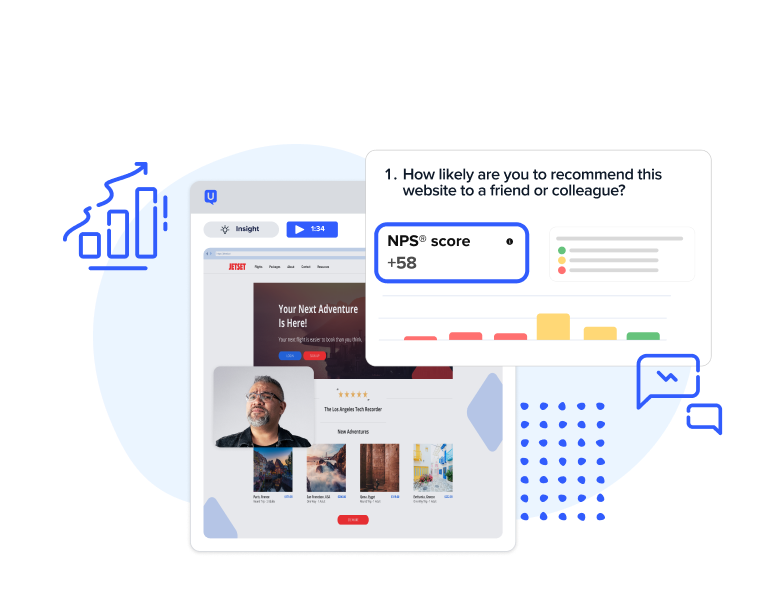
How to leverage Net Promoter Scores for better CX

When it comes to measuring customer advocacy, many businesses rely on Net Promoter Score (NPS) as a key metric. While NPS is a great tool, it’s important to remember that customer advocacy is only one part of the broader customer experience (CX).
In this post, we'll dive into how Net Promoter Score (NPS) fits into the customer journey, and how it works together with customer experience to help companies create brands that customers love.
What is a Net Promoter Score?
Net Promoter Score is a widely used customer experience metric used for measuring customer advocacy, providing insight into how likely customers are to recommend a brand. The metric emerged after decades of research conducted by consulting, marketing, and management firms that sought to find a formula that could express customer advocacy.
Several books and copious amounts of customer interaction later, the NPS framework was born; pioneered by Fred Reicheld, Bain & Company, and Satmetrix, who identified a single question that could effectively gauge customer sentiment. Their innovative work on “The One Number You Need to Grow” was published in the Harvard Business Review. NPS is a simple, yet powerful tool that remains central to measuring customer experience.
In short, the calculation aims to quantify customer feedback and sentiment—and, in many ways, advocacy—by asking a single question.
The Net Promoter Score survey question
After analyzing the purchase histories of more than 4,000 consumers and tracking whether those customers referred the brands they purchased from to others, Reicheld and his team realized the most effective way to measure customer advocacy was to ask this single question:
On a scale of 0 to 10, how likely are you to recommend this company’s product or service to a friend or a colleague?
Surprisingly, this question has proven to be the most accurate indicator of customer advocacy, and is now the industry standard. Reichheld had initially assumed that a question about brand loyalty—such as whether customers felt a company deserved their business—would provide the clearest insights. But the team quickly discovered that the real driver of growth wasn’t just loyalty; it was the act of advocacy itself—customers actively recommending a brand to others.
This shift in focus from loyalty to advocacy provides a key insight for businesses seeking to improve their customer journey. By understanding how likely customers are to promote a brand, companies can better gauge the health of their customer relationships and identify areas for improvement in their overall customer experience strategy.
How to calculate Net Promoter Score
The Net Promoter Score formula is straightforward. After being presented with the question above, respondents choose a score, typically between 0 and 10, with 0 meaning they’re 'not at all likely' to recommend the company/product/service and 10 meaning they’re 'extremely likely' to recommend the company/product/service.
Once all the responses are gathered, they’re grouped into three categories:
- NPS Detractor: Scores 0-6
- NPS Passive: Scores 7-8
- NPS Promoter: Scores 9-10

Then, the percentage of Detractors is subtracted from the percentage of Promoters to find the NPS. Scores can range between -100 and 100, with scores of zero and above considered good. (Passive scores are excluded from the calculation as they aren’t considered to either help or harm.)
What's a good Net Promoter Score?
As mentioned earlier, NPS can range from -100 (all scores 0) to 100 (all scores 10). A score of -100 isn’t remarkable and means that such a company has a lot of work to do to improve its CX.
Conversely, a good score doesn’t need to be 100—to date, no company has ever achieved a score of 100. However, some brands, like Starbucks and Costco, consistently receive high Net Promoter Scores (above 70).
Generally, most companies consider any score of 0 or higher positive. Nonetheless, what constitutes a “good” score can vary by industry.
For example, the industry average for Consumer Brands and Fast Food is 40, but the industry average for Telecommunications/ Cable/TV service is -5. The disparity in benchmarks across industries is wide, so it’s important to consider that when determining whether your NPS is good or bad.
Net Promoter Score as standalone data has its disadvantages
While Net Promoter Score can tell you who’s a self-proclaimed advocate for your brand, it’s no guarantee that your customer experience is top-notch.
Imagine a company sent out an NPS survey immediately after a customer’s purchase. The purchase experience was good, so the customer gave the company a high score. But, a few days later, when the customer received the product, it wasn’t what they had ordered and the return process was the polar opposite of the checkout process.
The customer is now frustrated and upset and has vowed never to make another purchase. If another NPS survey were sent out at this time, this customer would likely be a vocal detractor.
NPS captures just one point in time with a customer, and customer feedback will depend heavily on their most recent experience.
Focusing solely on NPS to measure overall CX is a dangerous habit that could eventually turn loyal promoters into detractors.
Net Promoter Scores aren't a guarantee
Self-reported data is notoriously inaccurate, which means that just because your customers say they’d recommend you doesn’t mean they will. Jacob Nielsen reports that his research shows that self-reported data from users tends to be heavily influenced by cognitive biases.
For example, a participant in a user research study may claim that they drink their coffee strong and black. However, when observed in their natural environment, researchers find they take cream and sugar.
The same logic can be applied to NPS results. A favorable score from a customer does not guarantee that the same customer will recommend your business to a friend.
NPS doesn’t show you the why behind your score
Probably the most important information NPS misses is the why behind your score. If your company recently received a high NPS, do you know why? And if the score isn’t great, how can you tell what needs improvement?
While some NPS surveys provide follow-up questions that enable customers to explain why they chose a particular score, this feedback relies solely on the customer’s memory of their interaction with a brand. That recollection may not be accurate or detailed enough to inform any actionable response.
How to pair
Like most quantitative metrics, NPS is a strong signifier of a companies’ strength in CX, but it should be paired with qualitative insights to bring the necessary context behind the score. In order to do this, many companies use their NPS to identify areas that need improvements then collect customer insights through qualitative research like usability studies to get a better understanding of why they scored the way they did.
By hearing your customers explain why they scored your business the way that they did, it’s much easier to adapt and meet their expectations in the future.
Think of NPS as similar to a survey or an A/B test. While it can guide you on what your customers are doing, you have limited ways of knowing why unless you conduct user research.
For example, if your NPS is high, qualitative research can reveal what your customers love about your product or service, and why. Watching users navigate your website or app and hearing them speak in their own words can give you an intuitive, actionable understanding of what drives that score.
Qualitative research can uncover hidden issues or even standout experiences for your users. You may discover that although your NPS is high, nearly every customer was having the same issue with your navigation, or that the copy on your pricing page doesn’t clearly explain what’s included in the price. On the other hand, you may realize something is really special about their experience that you can replicate somewhere else.
Observing what your customers say when they’re interacting with your brand puts the muscle you need behind your NPS to understand its meaning and make it immediately actionable.
Once you’ve established a regular research schedule, you can combine your NPS survey results with corresponding qualitative research and begin to benchmark your progress.
QXscore
While NPS provides a snapshot of customer sentiment at a specific point in time, pairing it with a QXscore provides a more comprehensive view of the customer experience over time. We created QXscore to quantify users’ attitudes and behaviors into a single, standardized score that’s easy to communicate to key stakeholders.
Unlike traditional metrics, QXscore combines attitudinal data such as ease of use, trust, appearance, and loyalty/Net Promoter Score (NPS), with behavioral data that measures task success. With QXscore, you can dive deeper into these areas and pinpoint more specific strengths and weaknesses that might otherwise go unnoticed, if you’re relying solely on NPS. It’s a powerful tool for tracking progress, prioritizing improvements, and driving data-backed decisions that enhance the overall user experience.
Keeping customers happy enough to continue coming back and recommending your brand is a perpetual process that involves your entire organization. Everyone from your sales team to customer service to the executive suite must be committed to building a people-centric company culture.
How Experian leveraged user research to support NPS
Here’s the situation. Experian researchers could obtain NPS feedback from power users in a fairly straightforward manner, but they couldn’t efficiently connect with—or elicit valuable, unfiltered insight directly from them. As a result, a massive portion of Experian’s user base was excluded from consideration when critical messaging and design decisions were made.
To combat this problem, Experian researchers leveraged user research to remotely speak with those power users and end-users. By starting with NPS data about end-user preferences, they were easily able to identify the enhancements that were necessary for the company’s products and services. However, they didn’t understand what exactly needed to be changed, and why.
The actionable qualitative human insights obtained directly from end-users helped the product team easily pivot and prioritize their sprints on work that delivered faster, more impactful results. Since starting on this journey of user research paired with NPS, they’ve realized a +20% process improvement for customers.
UserTesting is a more strategic approach than NPS alone and delivers deeper insight into why our users rate us the way they do. -Sr. Manager of UX Product Design, Experian
Customer experience is a moving target
You don’t want to miss the mark when it comes to understanding exactly how NPS is impacting your CX. Combining your NPS strategy with frequent qualitative research will help you zero in on what your customers really think—and how to make your products consistently exceed their expectations.






